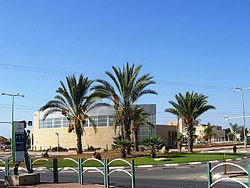Name meaning Horizons Local time Wednesday 11:44 PM | Founded 19 April 1955 Area 10 km² | |
 | ||
Weather 13°C, Wind NE at 8 km/h, 73% Humidity | ||
Ofakim (Hebrew: אֳפָקִים) (lit. "horizons") is a city in the Southern District of Israel, 20 kilometers west of Beersheba. It achieved municipal status in 1955. It has an area of 10,000 dunams. In 2015 it had a population of 25,638.
Contents
- Map of Ofakim Israel
- History
- Demographics
- Economy
- Education
- Sports
- Development plans
- Notable residents
- References
Map of Ofakim, Israel
History
Ofakim was established in 1955 as an urban center for the rural communities in the area. The early residents were Jewish immigrants from North Africa and India.
Demographics
In 2010, about one-fifth of the residents were ultra-Orthodox and one third were immigrants from the former Soviet Union. The rest are descendants of the founding generation, immigrants from North Africa and India who arrived in the town in the 1950s and 1960s. Ofakim also has a small community of Ethiopian Jews.
Economy
As in other development towns, the industrial sector has historically played an important part in Ofakim's economy. In 1972, 32% of the salaried workers (754 people) were in this sector, and in 1983—924 people (23%). During this period, the textile industries consistently employed by far the most workers, ranging from 72% (1982–83) to 82% (1972). The Of–Ar (short for Ofakim–Argentina) textile factory was a major employer.
Education
In 2001, there were 19 schools and 4,704 students in the city – 13 elementary schools (3,079 students), and 8 high schools (1,625 students). 43.3% of 12th grade students were entitled to a matriculation certificate.
Sports
One of Israel's 14 tennis centers is located in Ofakim. It opened in 1990 and has six courts. The city also has a soccer stadium.
Development plans
A train station opened in 2015 with a car park for 1,000 cars, and an old industrial building is being converted into an art museum. The Nahal Shomriya cycling route around Ofakim was inaugurated in 2010. The 60-centimeter-wide single route winds through 1,500 dunams (approx 375 acres) in Ofakim Forest, passing through Nahal Shomriya and Nahal Patish, and looping around eight local moshavim.
